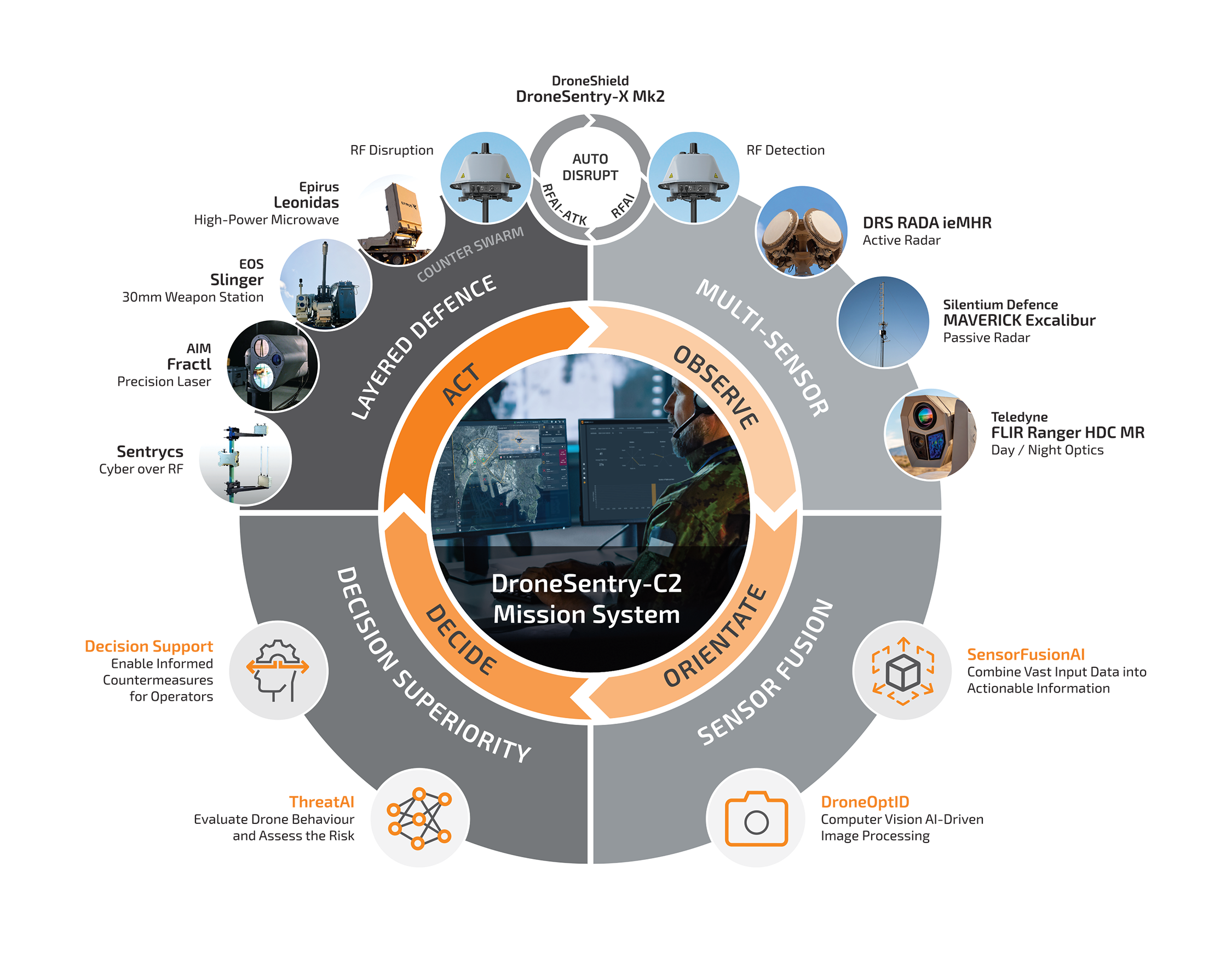Observe, Orient, Decide, Act: Countering Small Uncrewed Aerial Systems
This article originally appeared in DroneShield's Counter-Drone Policy and Tech Review Advertising Feature in The Australian (ACT circulation only) on 22 July 2025, and has been edited for clarity and length.
Written by AIRCDRE (Ret’d) Terry van Haren DSM, Vice President, Strategy and Director of DroneShield Defence Services at DroneShield.
Counter-drone solutions via AI-powered drone detection is heavily rooted in military strategy. Colonel John Boyd was a United States Air Force fighter pilot and theorist with combat experience in the Korean and Vietnam War. His signature concept, developed in the 1970s, was that the combat operations decision cycle was a continual process described as the OODA loop – a cycle that follows the steps of Observe, Orientate, Decide and Act. His theory was that to gain superiority over your adversary, your decision cycle had to outpace that of the adversary, and you needed to operate inside the adversary’s OODA loop to act and react quicker than your opponent.
Countering small Uncrewed Aerial Systems (sUAS) is again a contest of decision superiority and outperforming your adversary. Small UAS are fast, nimble, can attack in large numbers, and are highly manoeuvrable under First Person View (FPV) control. Add to that last-mile autonomy and counter-counter measures such as fibre-optic control, and survival is a matter of making decisions at speed and outperforming the adversary system, sometimes in close combat.
DroneShield advocates a C2 Mission System that follows Boyd’s OODA loop as a proven decision cycle that underpins critical defence operations. DroneShield’s DroneSentry-C2 provides a modular open systems approach that uses the best of Artificial Intelligence, fast edge computing and robust communications, to provide counter-drone technology superiority at the speed of relevance and the speed of the evolving threat.
Image: As in Boyd’s OODA Loop, defence against UAS requires a layered and integrated approach that enables the plug-and-play use of sensors and effectors and a capacity for rapid system refresh to keep pace with emerging threats and evolving technology.
Observe: Multi-Sensor Detection for Early Threat Recognition
Group 1 and 2 sUAS are small, nimble, fast, and can act in large numbers as swarms, designed to overwhelm defences. A well-flown FPV drone can be flown low through terrain to conduct a surprise attack on unsuspecting targets. To cover all possible approaches and all types of drones, DroneShield’s DroneSentry uses multi-sensor drone detection to detect, track, prioritise, and characterise sUAS. This includes Radio Frequency (RF) detection, active and passive radars, and electro-optical systems. No single sensor has all the answers, and multiple sensors are required to detect, track, and characterise threats in real time.
Orient: Sensor Fusion and AI-powered Optical Verification
Understanding drone type, characteristics, and intent is becoming just as important as detecting their presence. DroneShield’s platforms use advanced SensorFusionAI to correlate available sensor information to fuse a single track and analyse the drone’s characteristics, including their operating frequency, protocols, type by association, and potentially the location of the operator and fly-to-location.
DroneOptID AI is important in confirming that an object is a drone and not a bird or swarm of bats, and whether the drone is carrying a payload. SensorFusionAI and DroneOptID ensure the operator sees one target, one smooth track, and all available information so vital decisions can be made backed by relevant data.
Decide: AI-Powered Decision Superiority via ThreatAI
Determining the nature and status of a threat is vital to any operation. ThreatAI is a tool that will assist the operator with determining whether the drone is becoming a threat to your mission. With the ability to define the protected area, your boundaries, buffer zones, and local friendly fly areas, ThreatAI will scale the threat as it becomes more relevant, assisting the operator with Rules of Engagement (RoE) and potential collateral considerations. If the drone is not friendly and triggers your RoE, it will label the drone a 100 per cent threat and a hostile track, enabling immediate engagement. Given this AI will continuously calculate the threat equation on multiple drones, ThreatAI makes operator decisions easy in an overwhelming swarm attack environment, whether that be in an airport setting or in more active conflict zones.
Act: Layered Airspace Security through Soft and Hard-Kill Options
A choice of soft and hard-kill options provides flexibility of engagement types and the best chance of mission success. Soft kill options such as smart jamming provide the lowest AI-powered drone mitigation collateral options. Hard kill options, such as lasers, high powered microwaves, or remote weapons systems, will destroy the drone and may have other collateral impacts dependant on the operating environment. Whilst these considerations are important, the principal of layering defences and utilising the best matched effector is vitally important in a complex threat situation. In a worst-case scenario – a pop up FPV attack – the RF detection system of the DroneSentry-X Mk2, capable of detection and mitigation, may be authorised to automatically respond with smart jamming to close even a smaller OODA loop to outperform the adversary.
DroneShield’s DroneSentry-C2 is built to provide the operator multi-sensor-based decision superiority and the ability to out act, out react, and outperform the adversary though the use of a layered defence approach. This approach closes the OODA loop on the adversary, ensuring mission success whilst protecting lives and vital assets.


